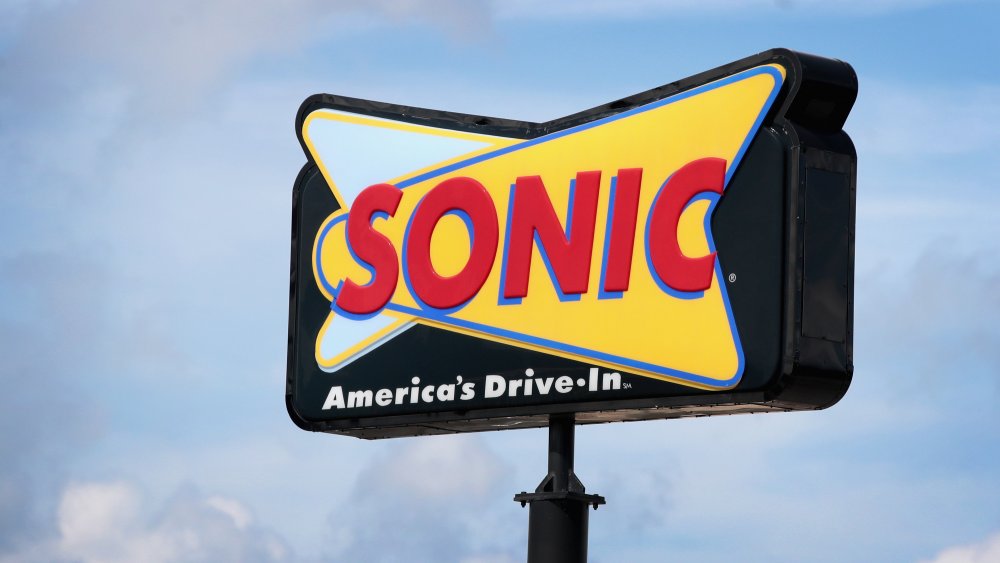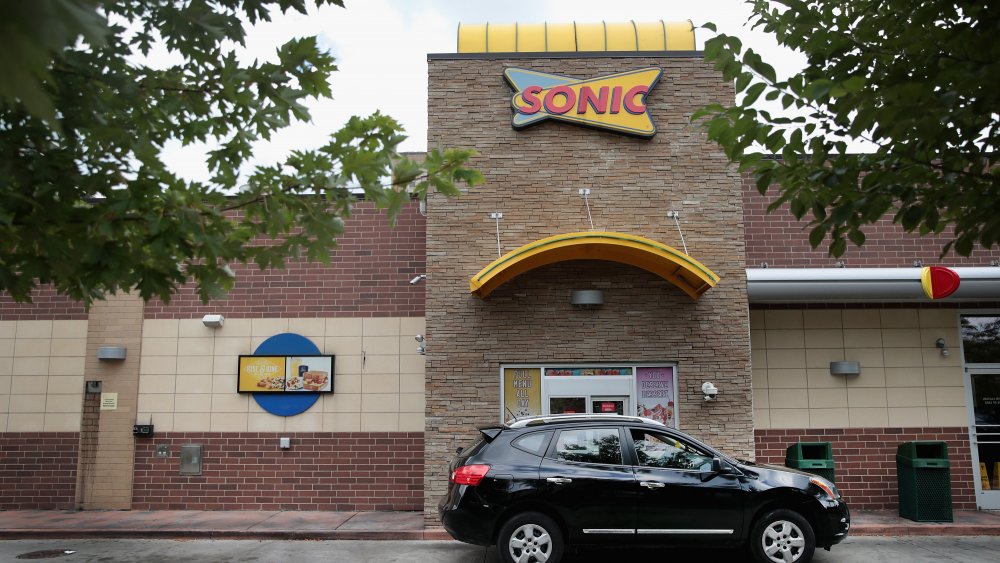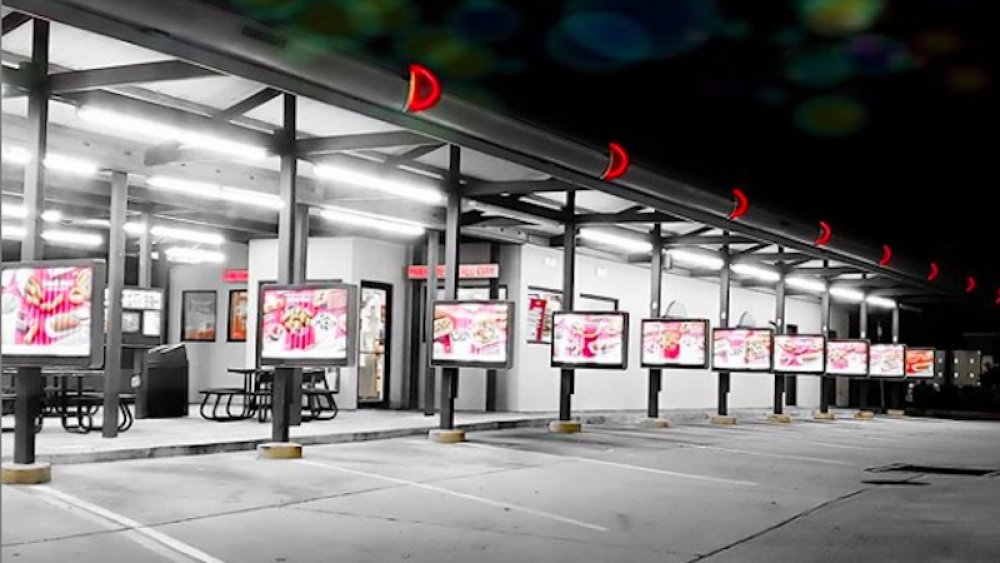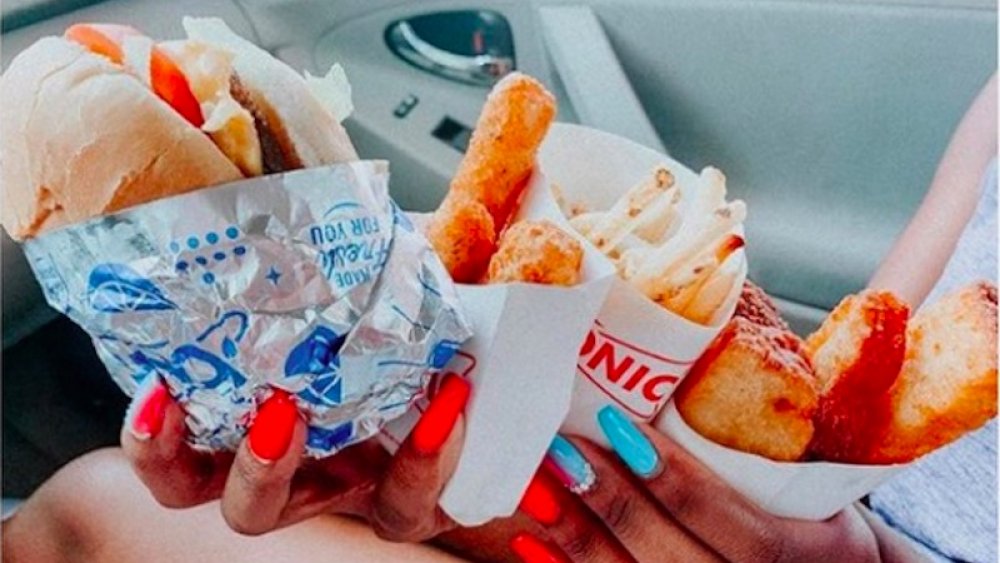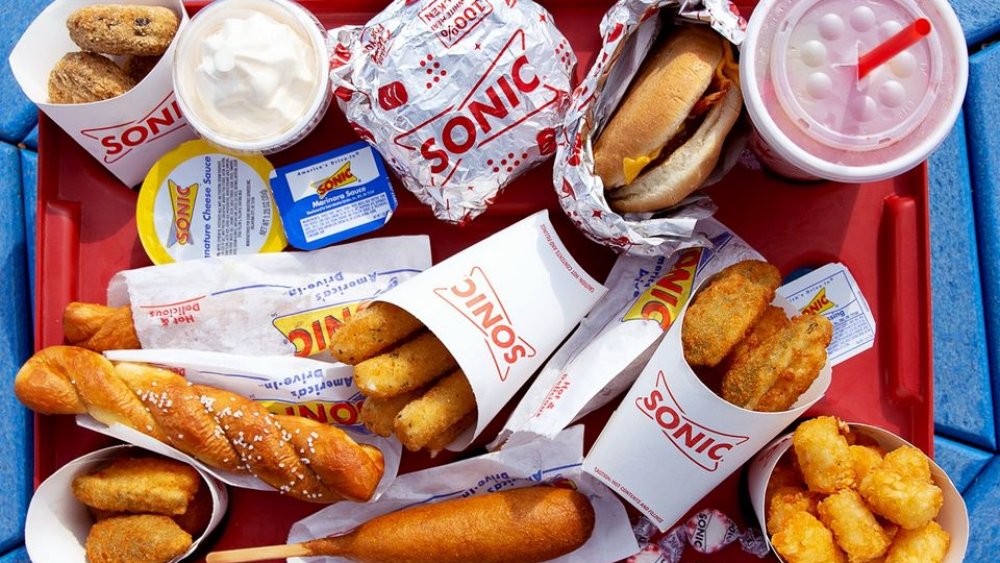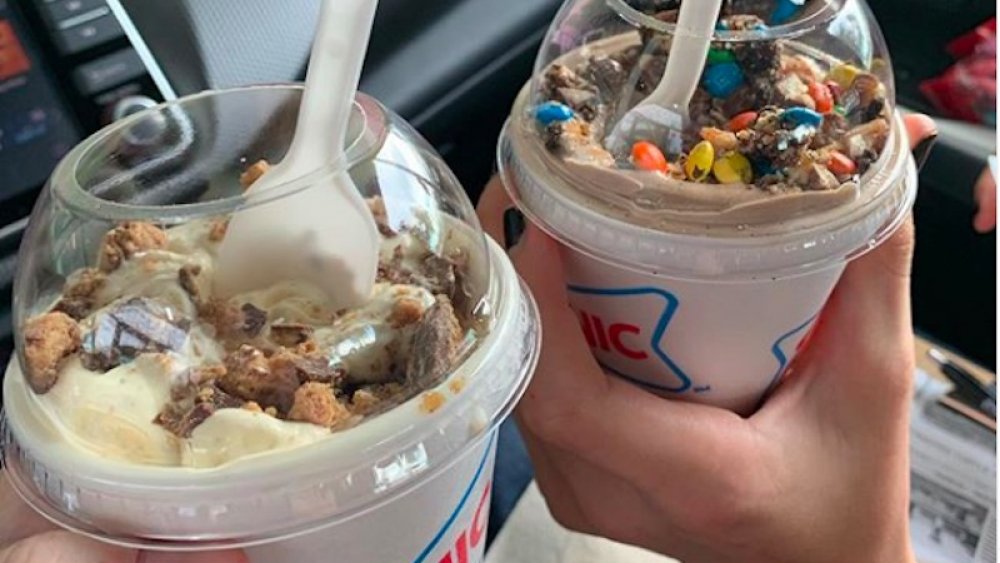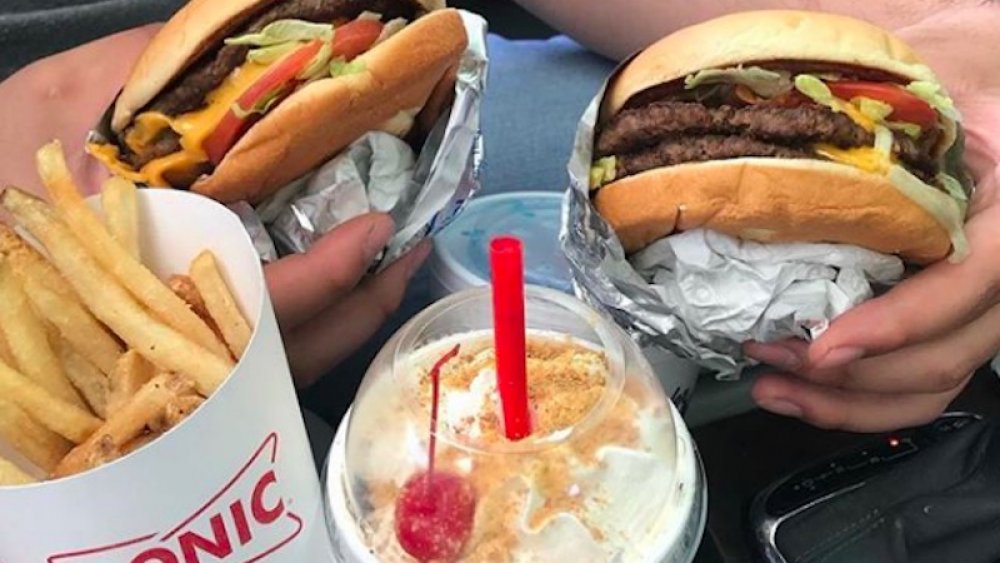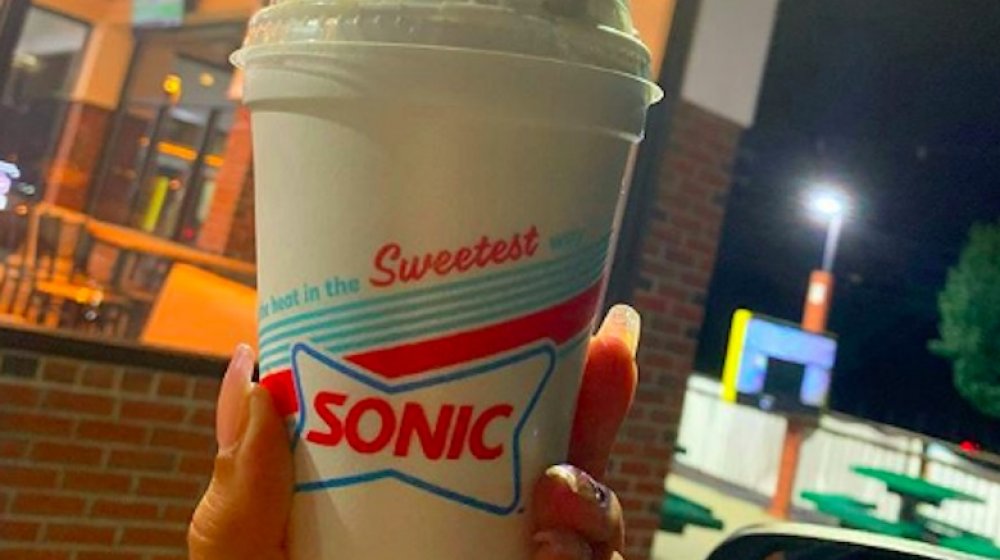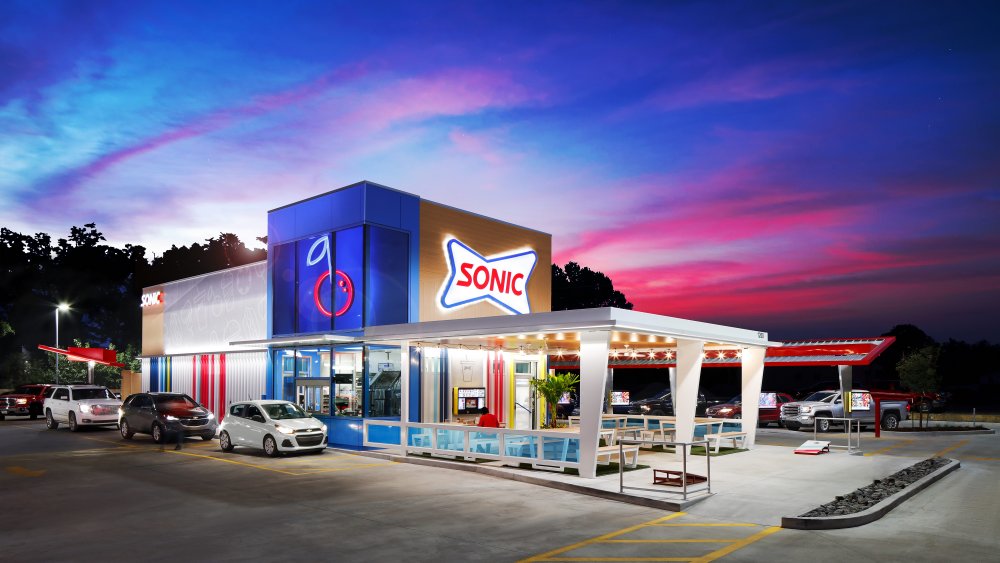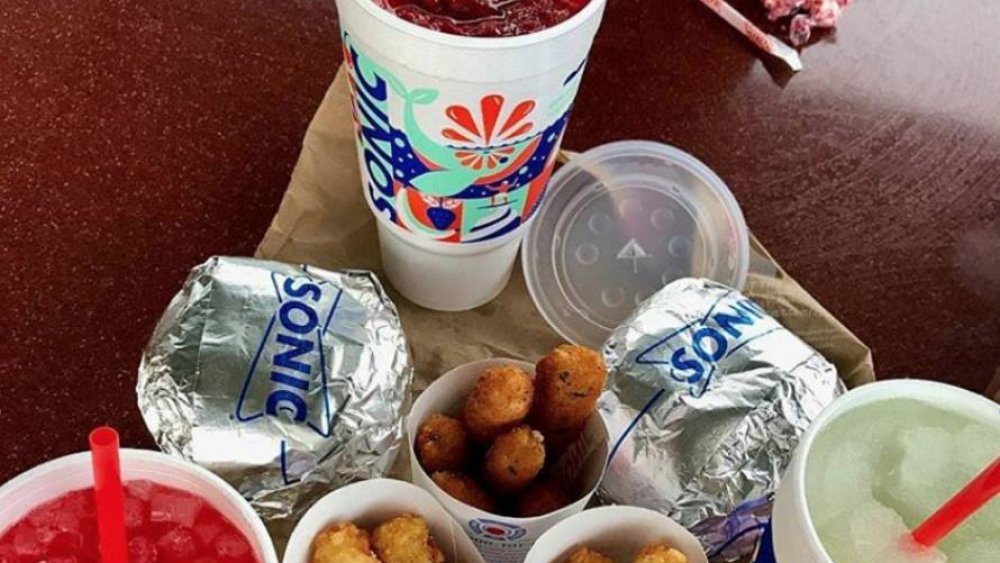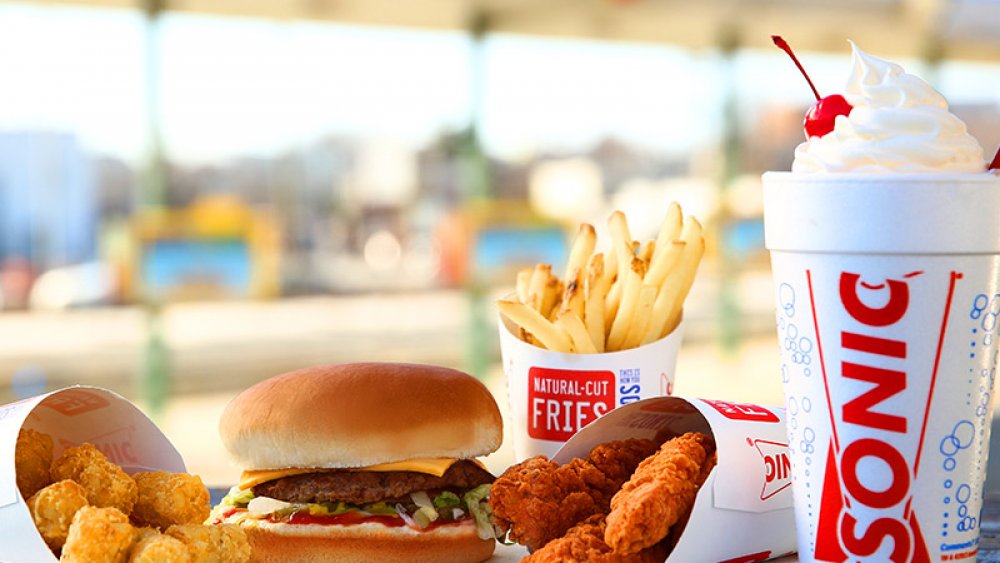Sonic Is Struggling To Stay In Business. Here's Why
There are few things more classically nostalgic than a burger and a milkshake – or, perhaps, a cherry limeade. That's the idea Sonic has been embodying as America's drive-in for decades.
Sonic Drive-In began as a humble root beer stand in Oklahoma back in 1953. Since then, Sonic has grown into a nationally beloved burger and beverage staple, with more than 3,500 locations in 44 states. Nowadays, Sonic is known for its eclectic menu of burgers, sandwiches, and snacks (who doesn't love those tots?!), not to mention the 1,063,953 drink combinations the company boasts.
However, despite offering all the drink combos of your dreams, Sonic has been struggling to stay in business for years in the face of growing competition and changing consumer attitudes. The company is making moves to try and turn things around, but will it work? Keep reading for all the details on Sonic's struggles, and what's giving the company hope.
Sonic is way behind the competition when it comes to sales and revenue
When it comes down to the hard numbers, some things just aren't adding up for Sonic. That wasn't always the case though. For the first half of the 2010s, Sonic was bringing in steady revenue as the nation's fourth largest fast food burger chain. While the company experienced its own so-called Sonic boom, its major competitors saw sales stagnate. Then, around 2015, things started to change. Sonic started seeing quarter after quarter of falling sales, a trend that didn't let up until 2019.
Today, Sonic continues to rank well below its major fast food competitors when it comes to sales and revenue. In Restaurant Business Magazine's ranking of the top 500 restaurant chains for 2019, Sonic came in at number 13, behind McDonald's, Burger King, and Wendy's. Other popular chains like Chick-fil-A, Chipotle, Taco Bell, and Subway also outrank Sonic when it comes to sales and revenue.
Sonic has blamed unfavorable weather for its sales woes
One of the reasons Sonic lags behind its competition is because it simply doesn't have as many store locations as some of the other big names. According to the company, the weather is to blame for that.
You heard that right. Sonic says it's really difficult to operate their drive-in model at some locations during snowy winter months and in super cold temperatures. It makes sense that carhops wouldn't fare so well at delivering burgers and corndogs on roller skates in the snow. Sonic says this is also partially why there are so many more franchise locations in the southern half of the country.
Beyond that, there is plenty of evidence out there about how bad weather can have negative impacts on the restaurant industry. Furthermore, scientists say climate change is causing bad weather like rain and snowstorms to get worse over time, obviously not ideal conditions for a trip to the drive-in. Just how much that has affected Sonic's bottom line is unclear. However, the company has specifically cited "unfavorable weather conditions" in the past when reporting negative quarters.
The fast food price wars have impacted Sonic's business
Some of Sonic's woes can be traced to the constant race to the bottom among fast food giants when it comes to prices. Big name chains are always evaluating their prices and deals, looking to squeeze out the competition dollar by dollar.
These price wars really kicked into high gear in 2017, with the launch of McDonald's reformatted value menu. In the wake, other major fast food chains began tweaking their own value menus, offering an array of items at heavily discounted prices. Sonic, on the other hand, was hesitant to stray from its own business model and really participate in the price wars, something that may be backfiring in the long run. Sonic does offer a range of constantly evolving deals and promotions, not to mention its daily happy hour offering half-price drinks and slushes. At the end of the day, though, it seems many customers just can't help but answer the hypnotizing call of the dollar menu.
Sonic doesn't appeal to health-conscious consumers
Another factor in Sonic's struggling sales is the changing attitudes among consumers when it comes to what they want from a fast food dining experience. In general, Americans have become more health-conscious, seeking out lower calorie options made with fresher, more natural ingredients. We've seen evidence of that in the rise of health-focused fast casual chains like Sweetgreen, Digg Inn, and Au Bon Pain.
Meanwhile, Sonic has been rated on more than one occasion as the most unhealthy fast food chain in America. A quick peek at their menu shows that even the most simple cheeseburger and fries combo can run you more than 1,000 calories, and it only goes up from there. If you want to go all out, a large Sonic Blast with M&M's is more than 1,500 calories by itself. In fact, the full array of Sonic blasts and other milkshakes are loaded with calories, fat, and added sugar across the board. In today's world of health-conscious consumers looking for low-carb options and less added sugars, Sonic's indulgent menu may only cut it on a cheat day, and that's simply not good for business.
Sonic doesn't appeal to young people as much as its competition does
When it comes to long term success, the key lies in marketing to future generations. And for Sonic, some of the chain's struggles may be traced back to its appeal among young people ... or lack thereof.
As it turns out, Sonic isn't a fan favorite among younger generations. The chain consistently ranks lower in surveys that cover Gen Z and Millennials' favorite fast food brands — if it even makes the list at all. That's a big problem, when estimates show that within the next decade, millennials are set to be the biggest spenders on food and beverage products. Sonic knows that it needs to appeal to young people to stay relevant, and the company has employed a number of strategies to try and win over more young customers, including more digital advertising targeted social media campaigns. Unfortunately, it seems those efforts haven't quite paid off in full.
In an attempt to save the business, Sonic was bought out by a restaurant conglomerate in 2018
By 2018, Sonic knew it needed to make some changes to save its business. Its sales were falling, it was in debt, and it needed resources. So, in September of that year, Sonic reached a deal with multi-brand restaurant conglomerate, Inspire Brands, which owns other niche restaurant chains like Arby's and Buffalo Wild Wings. Inspire Brands agreed to buy Sonic, and all of its debt, for $2.3 billion, and then use its resources to help "further drive innovation and long-term growth at Sonic."
The deal with Inspire Brands was completed by the end of 2018, along with a management shakeup for Sonic. The company's longtime CEO, Cliff Hudson, stepped down as part of the acquisition. Sonic's president at the time, Claudio San Pedro, took over as the head of the brand, under Inspire Brands leadership.
Sonic also announced a new logo and it did not go over well
A little more than a year after its acquisition by Inspire Brands, Sonic announced it was rolling out a new brand identity. Some of the changes included a new marketing campaign, and adjusting Sonic's tag line from "This is how you Sonic" to "This is how we Sonic." The company said the changes were aimed at celebrating how "customers are experiencing the brand, from their view."
Another update to Sonic's brand included a redesigned logo. Sonic announced the new logo in a twitter post in February of 2020 ... and let's just say fans weren't exactly impressed. User comments slammed the new design, and begged for the old logo back. People complained about the new font, and the awkwardly shaped background. One review even went so far as to say it "looks like a crooked bowtie on a sad party clown and the typography is atrocious." Yikes.
Sonic is pushing forward with its brand revamp anyways
The criticism of Sonic's new logo is not deterring the company's efforts to revamp its image. A few months after showing off its new look, Sonic announced a brand new restaurant design. The new restaurants feature a large brightly-lit cherry on top of the building, symbolic of the company's signature Cherry Limeades. They also have covered patios with string lights and lawn games, and completely redesigned kitchens.
You could be seeing one of these new Sonics near you soon. The first two newly designed stores have opened up in Oklahoma and Texas, and the company says some franchises are remodeling with the new design, along with up and coming locations.
You might also already be seeing Sonic's new ads playing on TV. The company's new marketing campaign said goodbye to the famous "Two Guys" and instead follows four families around America to "capture the hilarious and heartwarming moments that happen on the way to, at and from Sonic." In line with the company's new tagline and more engaging store design, the new ad campaign is focused on how real customers experience and embrace the Sonic brand in their everyday lives.
Sonic is also introducing new technology to win customers
As part of its effort to revive its image, Sonic is trying to make it as easy as possible for you to get your hands on its food and drinks using different innovative technology. To succeed with this, the company introduced an order-ahead feature on its mobile app in 2018. As if that wasn't easy enough, earlier this year, Sonic announced it was teaming up with Amazon to let customers order ahead through the Sonic mobile app simply by asking Alexa.
Could the robot uprising be linked to fast food? Probably not, but Sonic is looking into the future and testing AI-powered menus. The company partnered with Mastercard and ZIVELO to try out a fully digital ordering experience, with customers requesting their food and drinks from a kiosk with a voice ordering assistant. The new menus use an AI solution to automatically update with customized information based on factors like the weather, season, location, and time of day. And honestly, with more than a million possible drink combinations at Sonic, sometimes you just need help deciding what to order.
Don't worry, there's still hope for Sonic
While Sonic has been working hard for years to revive its brand and overcome its business struggles, one factor has proven itself to be a major boom for the company's sales. As it turns out, the COVID-19 pandemic has caused sales at Sonic to skyrocket in 2020.
According to parent company CEO Paul Brown, Sonic's success is thanks to its "car centric model." Sonic's drive in concept has always encouraged people to pull up and enjoy their meal right away from the comfort of their car. That's certainly an appealing option in the time of quarantine, with safety precautions in place and indoor dining so limited this year. Sonic says it has become one of the top performers in the industry this year, seeing a 30 percent spike in sales. On top of that, Sonic says new users on its mobile app more than doubled when COVID-19 cases surged in the spring of 2020.
Sonic's new strategies for growth were well underway before the pandemic began. It remains to be seen if those, along with the recent boom in popularity, will be enough to keep Sonic's nostalgic legacy as America's drive-in alive.
